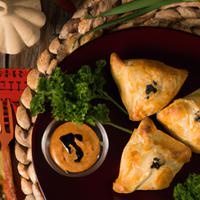
1 serving (100 grams) contains 300 calories, 10.0 grams of protein, 15.0 grams of fat, and 30.0 grams of carbohydrates.

Log this food in SnapCalorie

Nutrition Information
Calories |
714.3 | ||
|---|---|---|---|
% Daily Value* |
|||
| Total Fat | 35.7 g | 45% | |
| Saturated Fat | 11.9 g | 59% | |
| Polyunsaturated Fat | 0 g | ||
| Cholesterol | 71.4 mg | 23% | |
| Sodium | 952.4 mg | 41% | |
| Total Carbohydrates | 71.4 g | 25% | |
| Dietary Fiber | 2.4 g | 8% | |
| Sugars | 4.8 g | ||
| protein | 23.8 g | 47% | |
| Vitamin D | 0 mcg | 0% | |
| Calcium | 119.0 mg | 9% | |
| Iron | 4.8 mg | 26% | |
| Potassium | 357.1 mg | 7% | |
* Percent Daily Values are based on a 2,000 calorie diet. Your daily values may be higher or lower depending on your calorie needs.
Food Attributes
Source of Calories
About Samsa
Samsa, a popular dish in Central Asian cuisine, is a savory pastry typically filled with meat, onions, and spices, encased in flaky or doughy bread. Traditionally, lamb or beef is the primary filling, offering a rich source of protein, while onions add flavor and vitamins. Some variations may include vegetables like pumpkin or potatoes. Baked samsas are considered healthier than their fried counterparts due to reduced oil content. Samsas are rich in protein and iron from the meat but may be calorie-dense depending on the preparation method. They also contain carbohydrates from the pastry, fueling energy. While delectable, moderation is key, as samsas can be high in saturated fat, particularly when fried or made with fatty cuts of meat. These portable snacks are a favorite street food, offering a flavorful taste of Central Asian tradition with a balanced filling-to-pastry ratio.



